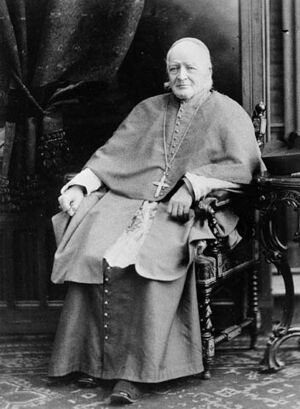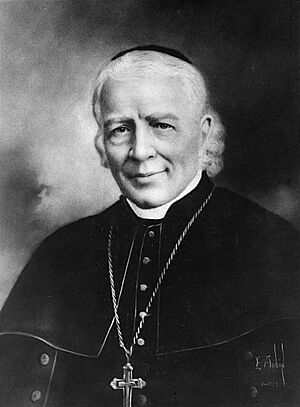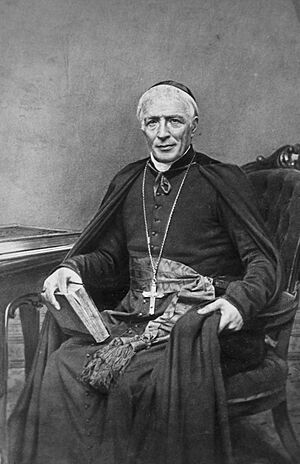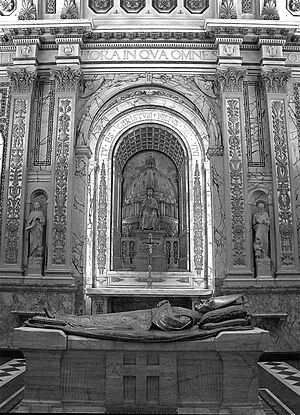Ignace Bourget facts for kids
Quick facts for kids His Grace the Right Reverend Ignace Bourget |
|
|---|---|
| Bishop of Montreal | |

Bourget in 1882
|
|
| Province | Quebec |
| Diocese | Montreal |
| See | Montreal |
| Enthroned | April 23, 1840 |
| Reign ended | May 11, 1876 |
| Predecessor | Jean-Jacques Lartigue |
| Successor | Edouard Charles Fabre |
| Other posts | Coadjutor Bishop of Montreal Titular Bishop of Telmesse Titular Archbishop of Marcianopolis |
| Orders | |
| Ordination | November 30, 1822 |
| Consecration | July 25, 1837 by Jean-Jacques Lartigue |
| Personal details | |
| Born | October 30, 1799 Lévis, Province of Lower Canada, British Empire |
| Died | June 8, 1885 (aged 85) Sault-au-Récollet, Montreal, Quebec, Canada |
| Buried | Mary, Queen of the World Cathedral. |
| Denomination | Roman Catholic |
| Parents | Pierre Bourget & Thérèse Paradis |
| Alma mater | Grand Séminaire de Québec |
Ignace Bourget (born October 30, 1799 – died June 8, 1885) was a Canadian Roman Catholic priest. He served as the Bishop of Montreal from 1840 to 1876.
Born in Lévis, Quebec, in 1799, Bourget joined the clergy at a young age. He studied religion for many years. In 1837, he became a co-adjutor bishop. This meant he was an assistant bishop with the right to take over. After Jean-Jacques Lartigue died in 1840, Bourget became the Bishop of Montreal.
During the 1840s, Bourget greatly expanded the Roman Catholic Church in Quebec. He encouraged missionary groups from Europe to come to Canada. These included the Oblates of Mary Immaculate and the Jesuits. He also started new religious groups in Montreal. Some of these were the Sisters of the Holy Names of Jesus and Mary and the Sisters of Providence.
Bourget also ordered the building of St James Cathedral. Today, it is known as Mary, Queen of the World Cathedral. He also helped start Université Laval and the Hospice of the Holy Child Jesus.
Bourget was a strong believer in ultramontanism. This idea meant he supported the Pope having supreme power. This included power over both religious and everyday matters. He often disagreed with Canadian government leaders. For example, he criticized the Institut Canadien de Montréal. He also defended parochial schools in New Brunswick.
In 1876, the Vatican began looking into his involvement in politics. Bourget then resigned as Bishop of Montreal. He retired to Sault-au-Récollet. He remained active in church life until his death in 1885.
Contents
Early Life and Studies
Bourget was born in Lévis, Quebec, on October 30, 1799. He was the eleventh of thirteen children. His parents were Pierre Bourget, a farmer, and Therese Paradis. He went to school at home and in Point Lévis. Later, he studied at the Petit Séminaire de Québec and the Grand Séminaire de Québec.
In 1818, he began studying theology at the Séminaire de Nicolet. He also taught Latin there. In 1821, he became a subdeacon. Soon after, he became secretary to Jean-Jacques Lartigue, a church leader in Montreal. In December 1821, he was made a deacon.
On November 30, 1822, Lartigue made Bourget a priest. Bourget then oversaw the building of Saint-Jacques Cathedral. The cathedral was finished in 1825. Bourget became its chaplain, responsible for church services.
In 1836, Montreal became a bishopric. Lartigue became the first Bishop of Montreal. He believed the Pope had supreme authority. Bourget shared this view. Lartigue asked Pope Gregory XVI to name Bourget as his successor. The Pope agreed. On March 10, 1837, Bourget became an honorary bishop. He also became Lartigue's assistant bishop with the right to succeed him. He was made a bishop on July 25, 1837.
The new Montreal diocese had 79 parishes and many missions. It served over 186,000 Catholics. In 1837 and 1838, the Lower Canada Rebellion took place. Both Lartigue and Bourget spoke out against the rebels. They urged Catholics to support the government.
Bishop of Montreal and Church Growth
On April 19, 1840, Bishop Lartigue died. Ignace Bourget became the Bishop of Montreal on April 23, 1840. He held this important position until 1876.
As bishop, Bourget continued to visit distant parishes. In 1840, he visited the Ottawa River area. There, he started eight new missions. These missions later became the basis for the diocese of Bytown. In the same year, he helped create the Sisters of Charity of Saint-Hyacinthe. This new group started a hospital in the Saint-Hyacinthe area.
From May to September 1841, Bourget visited Europe. He looked for new priests to work in Canada. Canada's population was growing, and more church workers were needed. He also discussed creating a church province to unite Canada's dioceses. He was impressed by the religious revival in France. His visit was seen as an invitation for missionaries to come to Montreal.
Many religious groups came to Montreal in the next few years. These included the Oblates of Mary Immaculate (1841) and the Jesuits (1842). When some groups couldn't come, Bourget started new ones in Montreal. In 1843, he founded the Sisters of Providence and the Sisters of the Holy Names of Jesus and Mary.
In 1844, the church province of Quebec was officially created. Bourget played a key role in this. He also helped with church developments in Kingston, Ontario. He invited the Congregation of Notre-Dame to start a school there. In 1845, he arranged for a hospital to be opened, staffed by nuns from Montreal.
On May 1, 1845, Bourget helped start the Hospice de Sainte-Pélagie. This Montreal institute helped unwed mothers. In 1848, he helped these helpers become nuns and form the Institute of Misericordia Sisters. This group was dedicated to helping mothers and their children.
In 1850, Bourget founded the Hospice du Saint-Enfant-Jesus. This institute cared for deaf-mutes. He also helped found the Sisters of Saint Ann that same year. In 1853, he started a society called Annales de la tempérance. This group worked to promote temperance, which meant avoiding alcohol.
Church Strengthening and Challenges

By 1846, Bourget felt that Archbishop Signay was blocking his plans. Signay disliked Bourget's changes. Bourget traveled to Rome in late 1846 to ask the Pope to accept Signay's resignation. He was not successful in this goal. However, he did achieve other successes. He helped establish the diocese of Bytown. He also secured 20 more religious staff for Montreal.
In 1847, a typhus epidemic hit Montreal. It was brought by Irish refugees from the Great Famine. Bourget and many church staff worked directly with the sick. Nine priests and thirteen nuns died while helping. Bourget himself caught the disease but survived.
Under Bourget, the Roman Catholic Church in Montreal began to focus more on ceremony. Bourget preferred Roman-style ceremonies. He brought holy relics from Rome for people to honor. He also introduced new devotions, like the Seven Sorrows of Mary.
On July 8, 1852, a large fire destroyed the Bishop's residence. It also destroyed Saint-Jacques Cathedral. Bourget planned to build a new cathedral. He wanted it to be a smaller copy of Rome's St Peter's Basilica. Construction began in 1875. After Bourget's death, it was completed in 1894. It was later renamed Mary, Queen of the World Cathedral.
Bourget and Politics
Bourget became concerned about the Institut Canadien de Montréal. This was a liberal literary group. Bourget saw it as anti-religious. In 1854, he influenced a church rule. It said that members of "anti-religious" literary groups could not receive Catholic sacraments.
In 1858, Bourget wrote letters attacking liberals and the Institut Canadien. He said that immoral books caused revolutions. He demanded that the Institut remove "evil books" from its library. He threatened to excommunicate anyone who visited the library. As a result, many members left the Institut.
Bourget continued to report negatively about the Institut to the Vatican. In 1869, one of their yearbooks was placed on the Vatican's list of banned books. The Institut's membership dropped sharply. By 1880, its library closed.
Bourget was also concerned about politics in Italy. Between 1849 and 1870, Italy became a unified nation. This greatly affected the Vatican. In 1870, the Papal States (lands ruled by the Pope) were taken over by Italy. This ended the Pope's rule over these lands. Bourget, as an ultramontane, strongly believed in the Pope's supreme authority.
In 1860, Bourget wrote letters about Italy's unification. He said the revolution in Italy was attacking the Church. He also said that liberal books and newspapers in Canada were helping this "conspiracy."
In 1862, Bourget traveled to Rome again. He was made a Roman count and an assistant to the Pope. In 1868, Bourget helped recruit Canadian Papal Zouaves. These were volunteer soldiers sent to Rome to help defend the Papal States. They were unsuccessful, and Rome was eventually taken over.
New Brunswick School Act
On April 5, 1871, a new law was proposed in New Brunswick. It would create government-run "common schools" with required attendance. On May 17, 1871, this bill became the Common Schools Act of 1871. This act banned teaching religion and religious clothing for teachers. It effectively ended the system of religious schools in New Brunswick.
Bishop John Sweeny of Saint John fought against this act. He urged Catholics not to pay the school tax. The government responded by jailing priests and taking property.
In 1873, Sweeny asked the bishops of Quebec to help. Bourget, who had helped create Quebec's religious school system, agreed. On May 19, Bourget and Bishop Louis-François Laflèche released a statement against the act. This caused political tension. The New Brunswick government offered a deal: they would pay the church's legal costs if a no-confidence motion against the government was dropped. The church accepted.
The legal challenge went to England's highest court, the Judicial Committee of the Privy Council. The court sided with the government. However, unhappiness with the act continued. In 1875, a protest in Caraquet, New Brunswick turned into a riot, and two people were shot. After this, the act was changed. Religious schools continued to receive some government support.
Bourget's public involvement in this issue may have stopped Quebec from adopting a similar secular school system. Quebec did not have a Ministry of Education for many years after this.
The Guibord Case
On November 18, 1869, Joseph Guibord died. He was a Catholic and a member of the Institut Canadien. His widow wanted him buried in Notre Dame des Neiges, a Catholic cemetery. However, because Bourget had previously spoken out against the Institut, Guibord was not allowed to be buried in the Catholic section. He was offered a burial in the non-Catholic section without religious rites. His widow refused. Guibord's body was temporarily placed in a Protestant cemetery vault.
Lawyers took the case to the highest court in Canada, the Judicial Committee of the Privy Council in England. They argued that the Church had a legal duty to give Guibord a Catholic burial.
In 1874, the Privy Council ruled that Guibord should be buried in the Catholic cemetery. They also ordered Bourget and the Church to pay the legal costs. After the ruling, Bourget went to the cemetery. He performed a ceremony to remove the sacredness from the burial plot where Guibord was to be buried. When Guibord's body arrived, an angry crowd threw rocks at the hearse. Soldiers had to escort the body to the grave.
Church Leadership Challenges
Université Laval
In 1852, Bourget helped found Université Laval. At first, he believed all bishops in Quebec would share control of the university. However, the archbishop and seminary of Quebec took over its management. By 1858, Montreal's Catholic colleges were not connected to the university.
This led Bourget to plan a new Catholic university in Montreal starting in 1862. He was concerned that Catholic students were going to secular schools like McGill College. In 1865, Bourget asked the Vatican to establish a new Catholic university in Montreal, but his request was denied.
In 1870, Université Laval suggested opening a branch in Montreal. Bourget rejected this idea because it would not be under his authority. In 1876, the Vatican ordered a branch of Université Laval to be established in Montreal. It would answer only to Quebec, not Bourget. However, Bourget resigned as Bishop shortly after, so he did not have to carry out this order.
Dividing Notre-Dame Parish
By 1863, the Notre-Dame parish in Montreal had grown very large, with about 100,000 people. The parish priest was traditionally the leader of the Sulpicians, a religious order. Bourget wanted the parish priest to be fully under his authority as bishop.
The Sulpicians disagreed with Bourget's idea. Both Bourget and the Sulpician leader were called to Rome. The Sulpicians refused to let Bourget have the power to dismiss the parish priest. They even threatened to remove all 57 of their priests from Montreal. This would have caused a huge shortage of clergy.
After talks, a compromise was reached in 1865. Bourget could divide the Notre-Dame parish into new parishes. The Sulpicians would name the priests for these new parishes, but the Bishop would officially appoint them. Also, either the Bishop or the Sulpician leader could dismiss the new parish priests.
Between 1866 and 1867, Bourget divided Notre-Dame into ten new parishes. However, to make them legal, they needed to be officially recognized by the government. The Sulpicians advised the government not to recognize them. This led to long legal and political battles. Bourget finally won in 1873, and all the new parishes were officially registered.
Resignation and Later Life
From October 27 to 30, 1872, Bourget celebrated 50 years since he became a priest. On May 1, 1873, he appointed Édouard-Charles Fabre as his assistant bishop. Around this time, Bourget was often ill. Despite this, he continued to strongly criticize liberalism, even within the Catholic Church.
These criticisms made the Archbishop of Quebec and others question Bourget's judgment. They were also worried that the church was getting too involved in politics. To avoid an official inquiry from Rome, Bourget resigned as Bishop of Montreal on April 28, 1876. The Pope accepted his resignation on May 15.
After resigning, Bourget was given the honorary title of archbishop of Marcianopolis. In early 1877, he retired to Sault-au-Récollet.
Between August and October 1881, Bourget traveled to Rome. He unsuccessfully argued for a second Catholic university in Montreal. In 1882, Bourget helped raise money to pay off the Diocese of Montreal's large debts. He announced that over $84,000 had been raised. On November 9, 1882, Bourget made his last public appearance. He celebrated 60 years since his ordination as a priest.
Bourget died on June 8, 1885, in Sault-au-Récollet. His funeral was held at the Church of Notre Dame. His body was buried next to his predecessor, Jean-Jacques Lartigue. They were placed in a vault under the dome of the unfinished St James Cathedral. This cathedral was later renamed Mary, Queen of the World Cathedral. In 1993, his remains were moved to the cathedral's special chapel for bishops.
On June 24, 1903, a statue of Bourget was unveiled outside St James Cathedral. The statue was created by artist Louis-Philippe Hébert. It was paid for by donations from Catholic clergy and followers. In 2005, the statue was cleaned and restored.
See also




